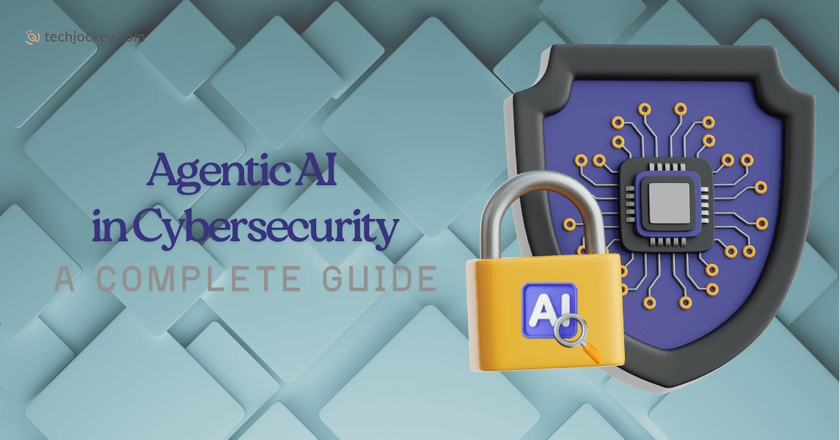How Agentic AI in Cybersecurity is Beating Hackers at Their Game?

Cybersecurity is a constant battle where attackers keep making use of smart AI tools to hack into systems and defenders, in response, are required to act fast in order to stay safe. This makes old security systems largely ineffective.
This is where agentic AI in cybersecurity comes into the picture and changes how companies protect their digital spaces. For these AI agents work on their own with purpose, strengthening defences and making security operations smarter and quicker.
Understanding how agentic AI works in cybersecurity and why it matters is thus of extreme importance today. For cyber threats are becoming more and more advanced with each passing day and only via quick responses can you evade falling prey to them.
What is Agentic AI?
Agentic AI refers to advanced artificial intelligence systems that can act on their own, adjust to new situations, remember past experiences, and plan ahead in smart ways.
Unlike traditional AI, which usually follows fixed rules or reacts to inputs, and generative AI, which creates content or predictions from learned data, agentic AI works with purpose. It understands its surroundings, learns from ongoing experiences, makes choices based on set goals, and changes its approach over time to stay effective and relevant.
Agentic AI’s core traits in cybersecurity include its ability to operate without constant human oversight, learn from new data and evolving threats to enhance decision-making, retain context and historical data to inform future actions, and develop multi-step strategies to achieve its objectives.
Outside cybersecurity, agentic AI systems are used in self-driving cars, smart trading tools, and automated factory robots, each handling complex tasks in changing conditions on their own. In cybersecurity, these same abilities help agents detect, rank, and stop threats without needing much help from humans.
Suggested Read: Agentic AI: A Complete Guide
Why Agentic AI is Needed in Cybersecurity?
Today’s Security Operations Centers (SOCs) deal with a host of challenges, such as…
- Escalating AI-Driven Threats: Attackers employ AI to create polymorphic malware, spear-phishing campaigns, and evasive attack vectors that evolve rapidly.
- Legacy Limitations: Traditional Cybersecurity tools are often reactive, rule-bound, and overwhelmed by vast alert volumes and false positives.
- Human Bottlenecks: Skilled analysts face alert fatigue and capacity limits that slow incident identification and response.
This crisis shows that human-only workflows and fixed tools are not enough to keep up with the speed and skill of AI-driven attacks.
Agentic AI in cybersecurity brings a major change by offering smart systems that can actively search for hidden threats, understand and fix complex problems, and update defences faster than people or regular tools can.
These systems boost the power of SOC teams, helping them cover more ground, respond faster, and lower risks in a fast-changing threat environment.
How Agentic AI in Cybersecurity Works ?
Some of the real-world cybersecurity applications of agentic AI include…
- Autonomous Threat Detection: Agentic AI constantly watches logs, network traffic, user actions, and system data. It spots strange behaviour and real threats in real time, cutting down the time between a breach and its discovery, and limiting how long attackers stay hidden.
- Incident Response Automation: Once a threat is found, agentic AI takes quick action like isolating devices, removing access, fixing systems, or blocking harmful IPs, all without waiting for human approval. This fast response helps stop threats and limits damage.
- Root Cause Analysis: By linking data from different sources like device logs, cloud activity, and network traffic, agentic AI finds where attacks started and what weaknesses were used. This helps teams fix problems faster and prevent future attacks.
- Proactive Defence: Agentic AI predicts weak spots and new attack methods, helping organizations strengthen systems before they are hit. This is key as zero-day and supply chain attacks grow more common.
- Insider Threat Detection: Agentic AI learns normal behaviour for users and devices, then flags unusual actions that may show insider threats or hacked accounts. These alerts help stop hidden risks from inside the organization.
- AI-Driven Threat Intelligence: Agentic AI studies global threat data to give useful insights quickly. For example, it can spot new phishing websites worldwide and block them early, protecting businesses everywhere.
- Continuous Remediation: Agentic AI fixes issues like misconfigurations and security gaps as they happen, such as closing a public cloud storage bucket and more, greatly cutting down the time systems stay exposed.
Adoption of Agentic AI in the Realm of Cybersecurity
Agentic AI adoption is accelerating across the cybersecurity industry. Read on to know how…
- CrowdStrike’s Agentic Security Platform uses smart AI agents for nonstop threat detection and automatic fixes, helping reduce the impact of breaches.
- Microsoft’s SOC tools use agentic AI to sort alerts, handle routine tasks, and give analysts deep insights, improving speed and accuracy.
- Big tech companies like Nvidia, Salesforce, and Meta are working together to grow agentic AI, adding it to cloud services, device protection, and compliance tools.
- Research shows 96% of organizations plan to use more agentic AI in cybersecurity next year, showing strong belief in its value.
- Experts say the future of agentic AI in security depends on mixing smart automation with clear reasoning and strong human control to build trust and improve results.
Agentic AI in Cybersecurity: Risks and Ethical Considerations
Despite its power, agentic AI introduces critical risks and ethical challenges. It connects deeply with networks and cloud systems, needing full access that may expose private data. Cloud-based work adds risk unless well protected.
Attacks on training data can further mislead agentic AI, causing wrong or risky actions. False outputs, called hallucinations, can harm automated responses. AI making decisions on its own can also lead to mistakes if not checked by humans. Keeping human-AI teamwork is key to staying safe and accountable.
Clear tracking of AI actions and strong rules for what it can do are thus needed to match agentic AI with company values and legal standards.
How Can You Prepare for the Agentic Future?
Organizations must carefully strategize agentic AI deployment for security and compliance…
- Hybrid Models: Use agentic AI to support human analysts by handling routine tasks, while people focus on oversight and tough decisions.
- Robust Oversight: Keep track of AI actions with constant checks. Set clear rules and approval steps, especially for major decisions.
- Regulatory Compliance: Make sure agentic AI follows laws and standards for privacy, data safety, and cybersecurity.
- Ethical Frameworks: Keep AI actions open and easy to explain, with systems that ensure responsibility and fairness.
- Training and Culture: Help security teams work well with AI agents by building trust and encouraging teamwork.
Conclusion
Agentic AI in cybersecurity is creating a new way to defend systems, where smart tools find, study, and stop threats faster and at a larger scale than human teams can. If you, too, thus wish to lay your hands on such agentic AI tools, get in touch with the Techjockey team today itself!
Yashika Aneja is a Senior Content Writer at Techjockey, with over 5 years of experience in content creation and management. From writing about normal everyday affairs to profound fact-based stories on wide-ranging themes, including environment, technology, education, politics, social media, travel, lifestyle so on and so forth, she... Read more








